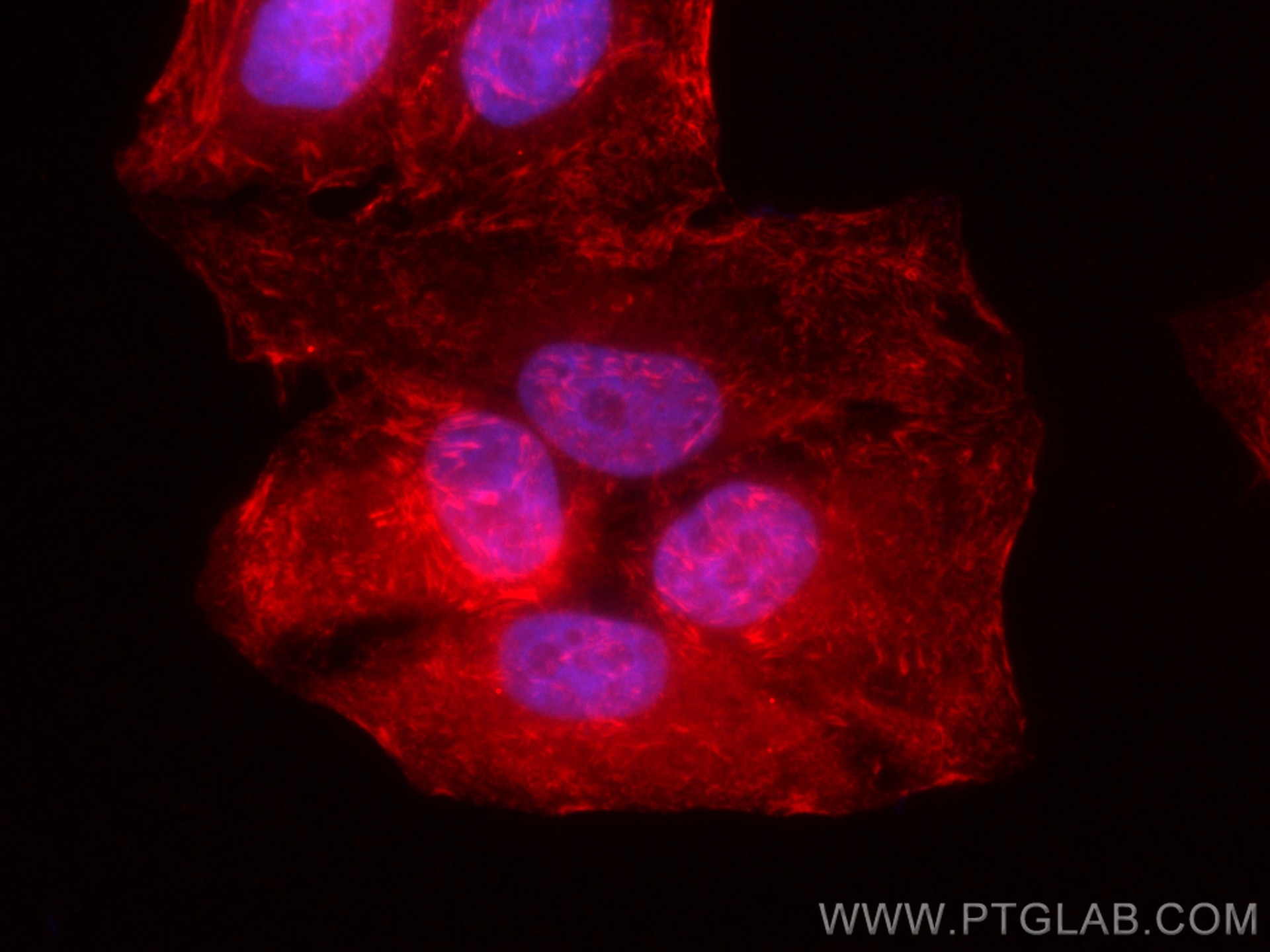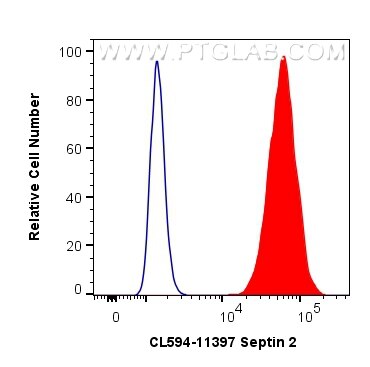- Featured Product
- KD/KO Validated
CoraLite®594-conjugated Septin 2 Polyclonal antibody
Septin 2 Polyclonal Antibody for IF, FC (Intra)
Host / Isotype
Rabbit / IgG
Reactivity
human, mouse, rat
Applications
IF, FC (Intra)
Conjugate
CoraLite®594 Fluorescent Dye
Cat no : CL594-11397
Synonyms
Validation Data Gallery
Tested Applications
| Positive IF detected in | HepG2 cells |
| Positive FC detected in | MCF-7 cells |
Recommended dilution
| Application | Dilution |
|---|---|
| Immunofluorescence (IF) | IF : 1:50-1:500 |
| Flow Cytometry (FC) | FC : 0.40 ug per 10^6 cells in a 100 µl suspension |
| It is recommended that this reagent should be titrated in each testing system to obtain optimal results. | |
| Sample-dependent, Check data in validation data gallery. | |
Product Information
CL594-11397 targets Septin 2 in IF, FC (Intra) applications and shows reactivity with human, mouse, rat samples.
| Tested Reactivity | human, mouse, rat |
| Host / Isotype | Rabbit / IgG |
| Class | Polyclonal |
| Type | Antibody |
| Immunogen | Septin 2 fusion protein Ag1946 |
| Full Name | septin 2 |
| Calculated Molecular Weight | 41 kDa |
| Observed Molecular Weight | 45 kDa |
| GenBank Accession Number | BC014455 |
| Gene Symbol | SEPT2 |
| Gene ID (NCBI) | 4735 |
| Conjugate | CoraLite®594 Fluorescent Dye |
| Excitation/Emission Maxima Wavelengths | 588 nm / 604 nm |
| Form | Liquid |
| Purification Method | Antigen affinity purification |
| Storage Buffer | PBS with 50% Glycerol, 0.05% Proclin300, 0.5% BSA, pH 7.3. |
| Storage Conditions | Store at -20°C. Avoid exposure to light. Stable for one year after shipment. Aliquoting is unnecessary for -20oC storage. 20ul sizes contain 0.1% BSA. |
Background Information
SEPT2 belongs to a family of septins, GTP-binding proteins that are a component of the cytoskeleton. Septins can assemble into intracellular structures of various shapes and are known to influence membrane stability, forming diffusion barriers and serving as scaffolds.
What is the molecular weight of SEPT2? Is SEPT2 post-translationally modified?
The molecular weight of SEPT2 is 45 kDa. In a cellular context, SEPT2 forms hetero-hexamers and hetero-octamers with other septins. These hexamers and octamers further assemble into high-order structures such as filaments and rings. SEPT2 can be phosphorylated on Ser218 by casein kinase 2 (PMID: 19165576) and can also be SUMOylated (PMID: 29051266).
What is the subcellular localization of SEPT2?
SEPT2 forms a diffusion barrier and localizes to the primary cilium; in some cell types, it has been found at the transition zone/basal body (PMID: 20558667), while in others localized to the axoneme (PMID: 23572511). During cell division, SEPT2 accumulates near the contractile ring from anaphase through telophase, and finally condenses into the midbody (PMID: 9203580). In interphase cells, SEPT2 was found to associate with polyglutamylated microtubules (PMID: 18209106) and can affect microtubule dynamics via interaction with MAP4.
What is the tissue expression pattern of SEPT2?
While some septins have tissue-specific expression profiles, SEPT2 is ubiquitously expressed (PMID: 22314400).
Protocols
| Product Specific Protocols | |
|---|---|
| IF protocol for CL594 Septin 2 antibody CL594-11397 | Download protocol |
| FC protocol for CL594 Septin 2 antibody CL594-11397 | Download protocol |
| Standard Protocols | |
|---|---|
| Click here to view our Standard Protocols |



